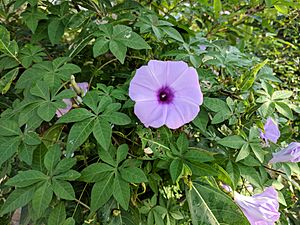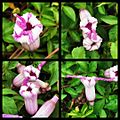Ipomoea cairica facts for kids
Quick facts for kids Ipomoea cairica |
|
|---|---|
 |
|
| Scientific classification | |
| Genus: |
Ipomoea
|
| Species: |
cairica
|
| Synonyms | |
|
Ipomoea palmata Forssk. |
|
Ipomoea cairica is a beautiful plant that grows like a vine, meaning it climbs and spreads. It's a type of herbaceous plant, which means it has soft, green stems instead of woody ones. This plant is also a perennial plant, so it lives for more than two years.
It has unique leaves that look like a hand with fingers, called palmate leaves. Its flowers are large and showy, ranging from white to a lovely lavender color. Ipomoea cairica is part of the morning glory family.
People call it by many names, like mile-a-minute vine, Messina creeper, Cairo morning glory, coast morning glory, and railroad creeper. The name cairica comes from Cairo, the city in Egypt where this plant was first found.
Contents
What Does the Cairo Morning Glory Look Like?
This plant is a slender climber that doesn't have hairs on its stems. It has bulb-like roots and a slightly woody base. Its leaves grow on stalks called petioles, which are about 2 to 6 centimeters long.
The leaf itself is shaped like an oval or circle, measuring 3 to 10 centimeters long and 6 to 9 centimeters wide. Each leaf is divided into five to seven parts, which are pointed at both ends. Sometimes, small side-leaves also grow.
Flowers and Seeds
The flowers are usually lavender-colored and grow in small clusters. The flower stalks are about 12 to 20 millimeters long. The green leaf-like parts that protect the bud, called sepals, are 6 to 8 millimeters long and pointed.
The main part of the flower, called the crown, is shaped like a funnel. It's 4 to 6 centimeters long and has a beautiful violet color. The parts that hold pollen (the stamens) and the part that receives pollen (the stylus) stay inside the flower. The part that develops into fruit (the ovary) is smooth.
After the flower blooms, it forms round fruits called capsules. These capsules are about 1 centimeter wide and contain one or two seeds. The seeds are covered in tiny hairs. This vine blooms often throughout the year, but it flowers most brightly from spring to summer.
Where Does the Cairo Morning Glory Grow?
Scientists aren't completely sure where this plant first came from. However, they believe it originally grew in a large area. This area stretches from Cape Verde (islands off the coast of Africa) all the way to the Arabian Peninsula. It includes northern Africa, tropical Africa, and the Mediterranean region.
This vine is a strong climber. It can cover walls, fences, or even trees. Its stems can grow to be longer than 10 meters! You can find it growing at different heights, from 250 meters to 2250 meters above sea level.
An Invasive Plant
Because people have moved this plant around the world, it now grows on most continents. In many places, it's an introduced species, meaning it's not native to that area. Sometimes, it becomes a noxious weed or an invasive species. This means it grows so fast and spreads so much that it can harm local plants and ecosystems.
For example, it's a problem along the coast of New South Wales in Australia. In the United States, it grows in Hawaii, California, and all the states along the Gulf Coast, as well as Arkansas and Missouri. It also grows in Brazil, where it is sometimes used in traditional medicine.
Growing the Cairo Morning Glory
Some plant nurseries sell Ipomoea cairica as an ornamental plant. People like to grow it because of its pretty purple flowers. It also grows very quickly, which makes it great for covering up fences or walls that don't look very nice.
If a piece of the plant breaks off, it can often grow into a new plant. It's important not to eat this plant, as it can cause health problems if swallowed.
Traditional Uses
Interestingly, many parts of the Ipomoea cairica plant can be eaten. Its young leaves are sometimes eaten, and its roots can be cooked before eating.
The Zulu people in Southern Africa use this plant for medicine. They crush its leaves and make a drink from them to help with rashes and fevers. In some areas, people also believe this plant has properties that can fight germs, like an antibiotic.
Gallery
-
A close-up of the flower in Hong Kong
-
The I. cairica vine growing in India
-
Covering a wall in Hyderabad
-
Growing like a small shrub
See also
 In Spanish: Bejuquillo de Caracas para niños
In Spanish: Bejuquillo de Caracas para niños













